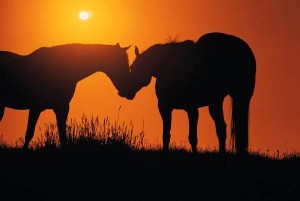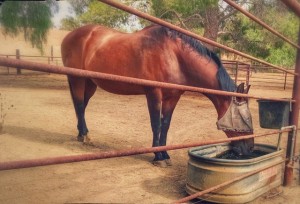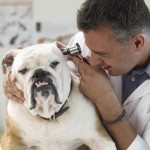Summertime is every horse owner’s favorite time of year. From local horse shows to national competitions, trail rides or horse camping, this is when we get to spend more time outside with our horses enjoying the long days and beautiful weather. But along with the summer fun, hot weather and high humidity in many areas can pose a risk to your horse.
Horses, just like people, have the ability to sweat and as the sweat evaporates, it works to help cool the skin down and moderate the body temperature. Sweat is made up of mostly water but it also contains electrolytes (sodium and chloride mainly) along with calcium, potassium and magnesium. So as your horse sweats, he is also losing these important elements. That’s why it’s so important to keep your horse hydrated especially since horses – due to their large size – can be prone to heat exhaustion or even heat stroke which can be very dangerous. So here are a few simple ways that you can help keep your horse hydrated and cool during the hot summer months.
How Much Water Does My Horse Need?
The amount of water your horse drinks each day really depends on a number of variables. At rest, an average sized horse (1,000 pounds) drinks between 8 to 10 gallons of water each day; when it’s hot and/or humid outside, your horse is going to drink even more water – sometimes twice as much – especially if they’ve been exercising and sweating. Your horses’ body is made up of approximately 70% water so obviously you’ll want to do everything you can to keep your horse hydrated!
Provide Clean, Fresh Water
The best way to keep your horse hydrated is to make sure he has access to clean, fresh water at all times. A good question to ask yourself: Would you drink the water that you expect your horse to drink? Chances are pretty good that if you wouldn’t want to drink the water, then your horse probably wouldn’t want to either. Make sure that the water you give your horse comes from a clean source and that his water buckets are always kept free of dirt, bugs, old hay or algae. If your horse’s water buckets are tipped over, leaky or smell funky, chances are high that your horse will not drink it or will not drink enough to stay properly hydrated.
Keep Water Available
Your horse shouldn’t have to go searching to find a clean water source – he should have easy access to water at all times. If your horse has access to a large turnout area or pasture in addition to a stall, there should be water available in all of these locations in addition to inside the stall. Horses prefer to drink cool water, so keep the water buckets, troughs or automatic waterers out of the sun in a shaded area so the water temperature can stay somewhere between 45-65 degrees F. This also applies to the water lines that lead to the waterers, since the sun can heat up the pipes to the point that the water that comes out is too hot for your horse to drink. Also, keep the water buckets in the same area every time so your horse knows where to go find it. And if you keep several horses together, it’s important that you provide more than one source of water so they don’t have to compete with each other over drinking the water.
Cleaning Water Buckets
Left long enough, your horse’s water will become stagnant and unhealthy. That’s why it’s important to develop a water bucket and trough cleaning schedule to keep his water clean and fresh. Make it part of your daily routine to check your horse’s water sources several times during the day, and empty the buckets or auto-waterers at least once a week to discourage mosquito and algae growth. Remember – one of the best ways to keep your horse hydrated is to keep his water fresh! Get a sturdy, long handled scrub brush to remove the grime and algae from the sides of the buckets. Dump out most of the water, then scrub the sides until they are completely clean, drain the remaining water and then refill it with cool, fresh water. If you use an automatic waterer, be sure to scrub under the metal flap where debris can accumulate. Also make sure you’ve dumped out any dirt or gravel that most likely has settled onto the bottom of the bowl.
On The Road
If you are out traveling with your horse either at a horse show or camping, your horse may be reluctant to drink the water if it tastes or smells different than the water he is accustomed to at home. Some horses won’t drink water that has been chlorinated or treated, like water that comes from city water plants, or they also might not like water that has higher levels of minerals such as water that comes from a natural water source like a spring or a well. So if you’re going on a short trip with your horse and you have storage capability, a great solution is to bring water from your home out on the road with you so that your horse will have drinking water that he’s accustomed to. Another solution is to use masking flavors such as Gatorade, peppermint extract or apple juice at home for a few days before transporting your horse, and then continue to use that flavoring in his water while you are out traveling. Remember – horses are usually very sensitive to changes in their water’s taste or smell, so you might need to get creative in coming up with different ways to keep your horse hydrated when on the road.
Another way to help keep your horse hydrated is to feed your horse wet hay or cubes. You can either soak your horse’s hay in water prior to feeding, or simply add his pellets or cubes to water and let them soak thoroughly (usually about 20 minutes). It’s best to feed the soaked meal to your horse immediately after soaking so as to prevent spoilage or fermentation. This is a great way to get extra water into your horse, since one flake of hay can absorb 1-2 gallons of water. Also, offering free access to salt blocks or loose salt in the feeder will also help encourage your horse to drink more water.
Extra Tips
In addition to providing your horse with plenty of fresh, cool water to drink, make sure your horse has a shaded area where he can get relief from the hot sun. A run in shed or shade-bearing trees are good options and if your horse is kept in a barn during the day, keep the barn windows and doors open for good cross-ventilation and proper air circulation. If your horse is in a pasture, then offer several shade options (especially if you have more than one horse) so they are not all competing for shady comfort.
For horses that are kept in barns, you can also install box fans or ceiling fans that will help move the air and improve the air circulation. Box fans and ceiling fans are not expensive and they work best with proper ventilation so that you’re not just circulating hot, stale air. The fans can be mounted on the walls and most come with mounting hardware – just make sure they are placed in safe areas where your horse cannot reach the cords or plugs. Another great cooling solution is to install water misters in your stalls and barn – they work well either alone or in conjunction with air fans. If you have good air circulation, installing the water misters might be all you need to help keep your horse cool.
And lastly, let’s not forget about our senior horses or horses with PPID (Cushing’s disease) that have thick, heavy coats. While the heavier coats may provide some protection from the sun, these dense coats tend to hold in the heat and make it hard for the horse to cool down. For these horses, clipping is important to help them stay cool.
Let’s hear what other additional tips you use to help keep your horse hydrated and cool in the summer!







Leave a Reply